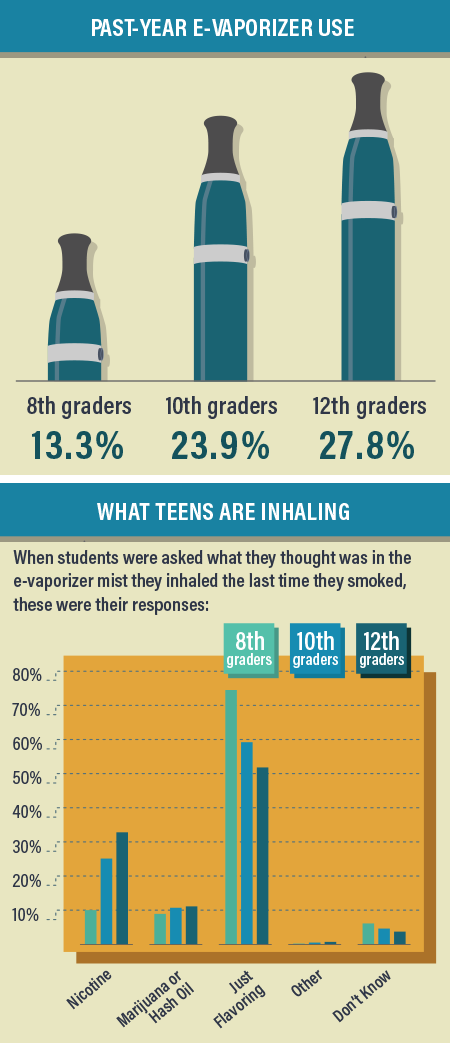Survey Reveals Popularity of Vaping by U.S. Youth
Abstract
The findings from the Monitoring the Future survey show that nearly 1 in 3 high school seniors vaped in 2017—and not always using nicotine.
About 13 percent of 8th graders, 24 percent of 10th graders, and nearly 28 percent of 12th graders at U.S. schools reported using a vaping device in the past year, according to data from the 2017 Monitoring the Future (MTF) survey. The survey results, which were released in December 2017, found that while most of these students said they mostly vape flavoring liquids, 1 in 10 reported vaping nicotine, and

1 in 20 reported vaping marijuana.
During a press conference discussing the findings of the MTF survey, National Institute on Drug Abuse (NIDA) Director Nora Volkow, M.D., expressed concern about the vaping statistics. She noted that some studies suggest that vaping can be a gateway to cigarette smoking.
“Potentially, we may lose all the gains we have made at lowering the smoking rates of adolescents in the past 20 years,” she said.
The 2017 survey, which included 43,703 students from 360 public and private schools, also revealed that about 1 in 5 adolescents who reported using marijuana said they did so solely via vaping.
The 2017 MTF survey was the first to ask detailed questions about vaping history and specific substances inhaled, said Richard Miech, Ph.D., a research professor at the University of Michigan Institute for Social Research. The institute has conducted the MTF—an annual nationwide survey of students in grades 8, 10, and 12—on behalf of NIDA since 1975.
Miech said that these questions were added to keep up with the gradual evolution of vaping devices and enable more accurate tracking of trends.
The popularity of vaping among teens is one of the few negative trends on an otherwise positive report that recorded the lowest levels of legal and illicit drug use among teens in years or even decades. The use of heroin, methamphetamines, and tobacco cigarettes all reached all-time lows.
The rate of teens misusing opioid pain medications has also dropped dramatically in the past few years, which is encouraging given the opioid crisis involving adults in the United States. For example, only 2 percent of 12th graders reported they used Vicodin in 2017, which is significantly down from 2.9 percent in 2016 and 10.5 percent in 2003. In the past year, there were also drops in Vicodin use among 10th graders (from 1.7 to 1.5 percent) and 8th graders (from 0.8 to 0.7 percent), but these declines were not statistically significant.
A total of 2.7 percent of seniors reported past-year misuse of the prescription opioid OxyContin—a drop from 5.5 percent at its peak in 2005.
“The decline in both the misuse and perceived availability of opioid medications may reflect recent public health initiatives to discourage opioid misuse to address this crisis,” Volkow said in a press statement. “However, with each new class of teens entering the challenging years of middle and high school, we must remain vigilant in our prevention efforts targeting young people, the adults who nurture and influence them, and the health care providers who treat them.”
Lloyd Johnston, Ph.D., the Angus Campbell Collegiate Research Professor at the Institute for Social Research and “father of the MTF” also cautioned against becoming complacent in the wake of these data. “We cannot take our eyes off the prize,” he said.
He noted that adolescents have reported that a lack (or at least perceived lack) of availability of drugs deters their use. Perceptions about the risks associated with drugs, meanwhile, have remained fairly level over the past several years. ■
More information from the 2017 MTF survey can be accessed here.



